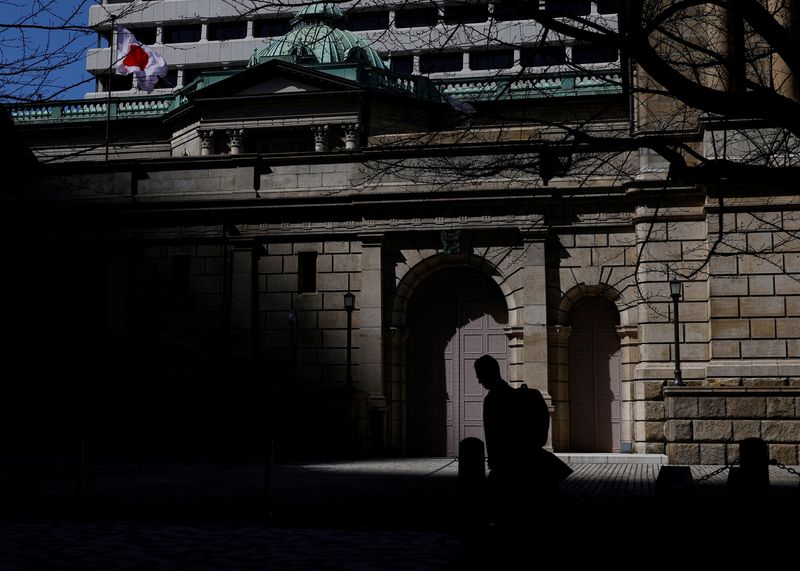BOJ’s long battle with deflation and the great unwinding

A man walks past the Bank of Japan building in Tokyo, Japan March 18, 2024. REUTERS/Kim Kyung-Hoon/File photo
US10Y…
-0.39%
Add to/Remove from Watchlist
Add to Watchlist
Add Position
Position added successfully to:
Please name your holdings portfolio
Type:
BUY
SELL
Date:
Amount:
Price
Point Value:
Leverage:
1:1
1:10
1:25
1:50
1:100
1:200
1:400
1:500
1:1000
Commission:
Create New Watchlist
Create
Create a new holdings portfolio
Add
Create
+ Add another position
Close
TOKYO (Reuters) – The Bank of Japan (BOJ) ended eight years of negative interest rates and other pieces of unorthodox policy on Tuesday, making a historic shift away from decades of massive monetary stimulus.
Here is a timeline of key moments in the BOJ’s battle with decades-long deflation and the gradual unwinding of its radical monetary stimulus.
1999
February – BOJ introduces zero interest rate policy.
2000
August – BOJ raises short-term target to 0.25%, a move criticised as premature as Japan suffers a domestic banking crisis.
2001
March – BOJ adopts quantitative easing (QE), shifts policy target from interest rates to pace of money printing.
2006
March – BOJ exits QE, shifts back to interest rate target.
July – BOJ raises short-term rates to 0.25%.
2007
February – BOJ raises short-term rates to 0.5% from 0.25%.
2008
October – BOJ cuts short-term rates to 0.3% from 0.5% to fend off economic shocks from the collapse of Lehman Brothers.
December – BOJ cuts short-term rates to 0.1% from 0.3%.
2010
October – BOJ cuts short-term rates to 0-0.1%, starts buying risky assets like exchange-traded funds (ETF) as part of a newly introduced asset-buying programme.
2013
January – BOJ adopts 2% inflation target, signs agreement with government pledging to meet the target “at the earliest date possible.”
April – BOJ Governor Haruhiko Kuroda adopts new asset-buying scheme dubbed “quantitative and qualitative easing” (QQE), commits to achieving 2% inflation in roughly two years.
2014
October – BOJ expands QQE, increases purchases of government bonds, ETFs.
2016
January – BOJ adds negative interest rate policy, and applies a 0.1% charge to a small pool of excess reserves financial institutions park with the central bank.
July – BOJ eases monetary policy, ramps up ETF buying.
September – BOJ adopts yield curve control (YCC), shifts policy target to interest rates from pace of money printing and introduces 10-year bond yield target of around 0%.
2018
April – Kuroda re-appointed for a second term as governor.
July – BOJ clarifies it will allow the 10-year yield to move 10 basis points either side of its 0% target.
2021
March – BOJ conducts “comprehensive assessment” of YCC to address its side-effects. It decides to taper ETF buying, widen the 10-year yield band to 25 basis points up and down the 0% target and adopts new market operation that allows it to buy an unlimited amount of 10-year bonds at a fixed rate.
2022
May – BOJ begins to offer buying unlimited amount of 10-year bonds at a fixed rate on a daily basis, as long-term interest rates approached its 0.25% cap more frequently than before
December – BOJ widens 10-year yield band to 50 basis points up and down the 0% target, a move aimed at easing some of the cost of prolonged stimulus.
2023
April – Kazuo Ueda becomes BOJ governor, removes guidance pledging to keep interest rates at “current levels or lower” and announces plans to conduct a comprehensive review of past monetary easing measures.
July – BOJ tweaks YCC by raising yield cap to 1% from 0.5%.
October – BOJ tweaks YCC by re-defining 1% cap as a loose reference, a move seen as essentially dismantling yield control.
2024
March – BOJ dismantles massive stimulus programme by ending negative rate policy, YCC and risky asset purchases. Overnight call rate set as BOJ’s new policy target.








